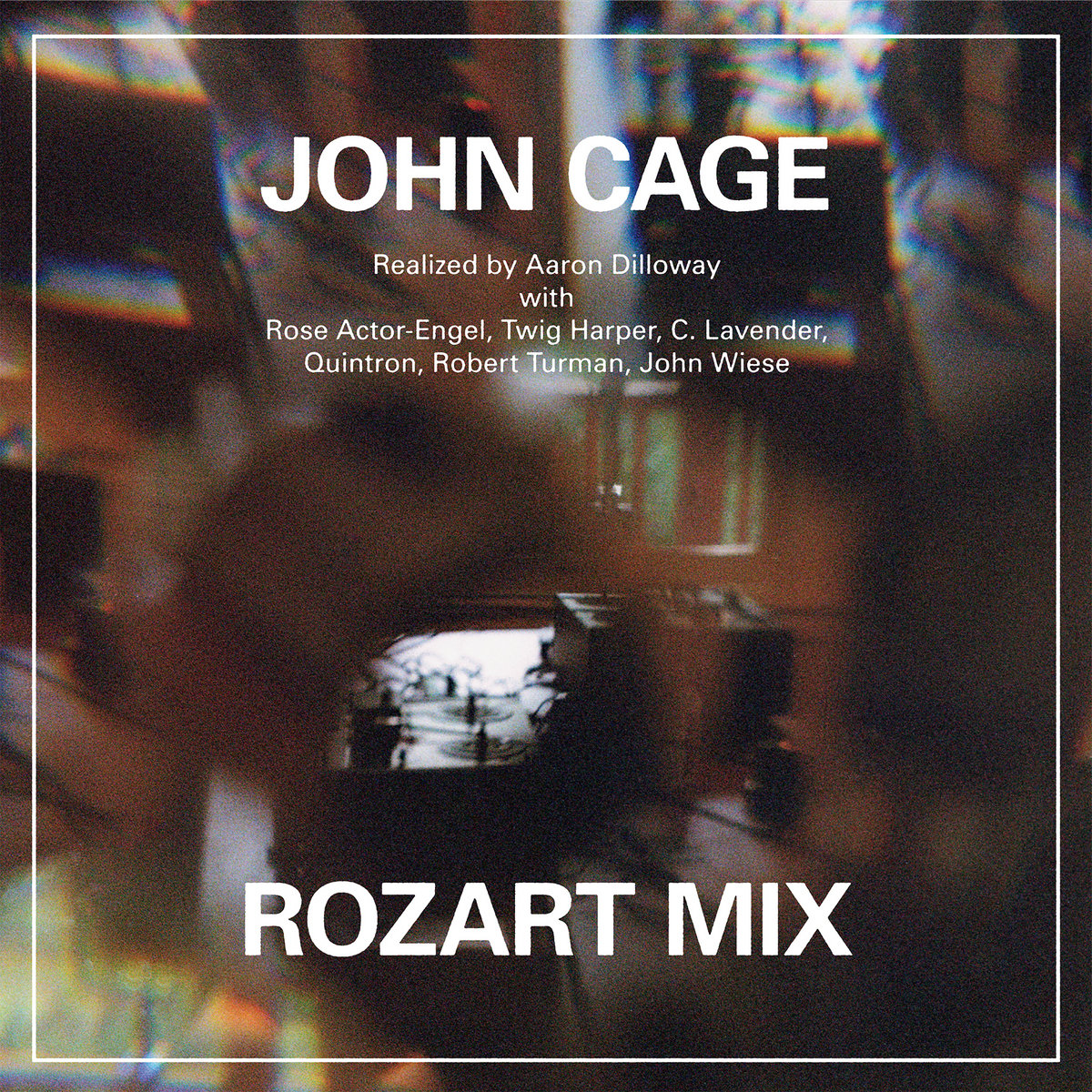 In 1965, John Cage "composed" a piece for Alvin Lucier that debuted at Brandeis University's then-new Rose Art Museum (Lucier was employed as Brandeis's chorus director at the time). The score for the piece was characteristically Cage-ian, as it was essentially just "correspondence and notes regarding the preparation of magnetic tape" and left plenty of room for chance and spontaneity to play significant roles. While Cage settled upon a total of 88 loops to mirror the number of keys on a piano, the contents and length of those loops were left very open-ended (as was the duration of the piece itself, as its beginning and ending were determined by the arrival and departure of the audience). There was also an element of mischief to the piece as well, as Cage's original vision included loops as long as 45 feet that stretched over a fountain and also included instructions for what to do when some of the loops inevitably broke mid-performance. Unsurprisingly, performances of "Rozart Mix" are quite rare for those reasons, but Aaron Dilloway was recently lucky enough to land the time and resources necessary to perform his own personalized interpretation and there is literally no one on earth who could be better suited for such an endeavor.
In 1965, John Cage "composed" a piece for Alvin Lucier that debuted at Brandeis University's then-new Rose Art Museum (Lucier was employed as Brandeis's chorus director at the time). The score for the piece was characteristically Cage-ian, as it was essentially just "correspondence and notes regarding the preparation of magnetic tape" and left plenty of room for chance and spontaneity to play significant roles. While Cage settled upon a total of 88 loops to mirror the number of keys on a piano, the contents and length of those loops were left very open-ended (as was the duration of the piece itself, as its beginning and ending were determined by the arrival and departure of the audience). There was also an element of mischief to the piece as well, as Cage's original vision included loops as long as 45 feet that stretched over a fountain and also included instructions for what to do when some of the loops inevitably broke mid-performance. Unsurprisingly, performances of "Rozart Mix" are quite rare for those reasons, but Aaron Dilloway was recently lucky enough to land the time and resources necessary to perform his own personalized interpretation and there is literally no one on earth who could be better suited for such an endeavor.
This album's origins date back to 2020, as Dilloway was contacted by the John Cage Trust and Acra, NY's Wave Farm about staging a fresh performance of the piece. The following year, Dilloway spent "a wonderful and intense week" at Bard College researching Cage's notes and materials, then performed a 6-hour version at the Trust with the assistance of Rose Actor-Engel, Twig Harper, C. Lavender, Quintron, Robert Turman, and John Wiese. According to Dilloway, the performance involved "12 individually amplified reel to reel tape machines, placed around multiple floors of a house, playing 88 tape loops spliced together by 5 to 175 splices" and "created an overwhelming and joyous environment of cacophonous sound." Amusingly, that performance just leapt to the top of my ever-expanding list of "missed concert" regrets, as I used to live a mere 10 minutes from Bard College. Alas. On the bright side, the durational constraints of vinyl have distilled that performance to a mere 16 minutes of surrealist magic that I can now experience at home. It is certainly less immersive and hypnotic than a 6-hour dose would be, but the new brevity imbues the piece with the "all killer, no filler" feel of a great noise set, so I am definitely not complaining.


 This unique quartet unusually originated as a collaboration between two French photographers, as Frédéric D. Oberland and Grégory Dargent performed some improvised duo concerts a few years back to accompany screenings and exhibits in Cairo, Beirut, and elsewhere. The duo was then expanded into a quartet to include Lebanese bassist Tony Elieh and darbuka player Wassim Halal and a three-day "improvised sound bacchanalia" ensued. The foursome describe themselves as a "post-anything quartet featuring multi-instrumentalists from the Mediterranean inland Sea" and share an ambitious vision of "new folklore for a devastated planet" and "tangos danced on the glowing ashes of our days." In less colorfully poetic terms, SIHR is a visceral and freewheeling collision of Arabic percussion, snatches of Middle Eastern melodies, timeless folk instrumentation, and ambitiously weird/mangled/abused synth sounds. In fact, literally everyone other than Halal plays a synth of some kind, which makes for a deeply strange collision of traditional music and outré electronics. While SIHR only fully transcends its improvisatory roots on the more melodic and sax-driven "YouGotALight," the album as a whole is an oft-fascinating outlier and this quartet truly never resembles any other improv ensemble that I have encountered.
This unique quartet unusually originated as a collaboration between two French photographers, as Frédéric D. Oberland and Grégory Dargent performed some improvised duo concerts a few years back to accompany screenings and exhibits in Cairo, Beirut, and elsewhere. The duo was then expanded into a quartet to include Lebanese bassist Tony Elieh and darbuka player Wassim Halal and a three-day "improvised sound bacchanalia" ensued. The foursome describe themselves as a "post-anything quartet featuring multi-instrumentalists from the Mediterranean inland Sea" and share an ambitious vision of "new folklore for a devastated planet" and "tangos danced on the glowing ashes of our days." In less colorfully poetic terms, SIHR is a visceral and freewheeling collision of Arabic percussion, snatches of Middle Eastern melodies, timeless folk instrumentation, and ambitiously weird/mangled/abused synth sounds. In fact, literally everyone other than Halal plays a synth of some kind, which makes for a deeply strange collision of traditional music and outré electronics. While SIHR only fully transcends its improvisatory roots on the more melodic and sax-driven "YouGotALight," the album as a whole is an oft-fascinating outlier and this quartet truly never resembles any other improv ensemble that I have encountered. As far as I can tell, this is probably Diamanda Galás's tenth live album to date and it documents a pair of 2017 performances in Chicago and Seattle (Galás's previous live album, At Saint Thomas the Apostle Harlem, dates from the previous year). For the uninitiated, that probably sounds like an excessive number of live albums, but the improvisatory nature of Diamanda's art ensures that every single live performance is a truly singular event. Of course, actually experiencing Diamanda Galás live (an essential experience) is not quite the same as hearing a recording of the performance, much like watching a professionally shot video of a burning house is not quite the same as actually being inside one. That said, it is still a wild and compelling experience nonetheless and the lines between studio albums and live albums are increasingly academic given her volcanic spontaneity and preference for single-take recordings. The similarities to jazz do not end there, however, as Diamanda Galás in Concert is devoted to radical piano-and-voice interpretations of an eclectic and fascinating array of unconventional standards.
As far as I can tell, this is probably Diamanda Galás's tenth live album to date and it documents a pair of 2017 performances in Chicago and Seattle (Galás's previous live album, At Saint Thomas the Apostle Harlem, dates from the previous year). For the uninitiated, that probably sounds like an excessive number of live albums, but the improvisatory nature of Diamanda's art ensures that every single live performance is a truly singular event. Of course, actually experiencing Diamanda Galás live (an essential experience) is not quite the same as hearing a recording of the performance, much like watching a professionally shot video of a burning house is not quite the same as actually being inside one. That said, it is still a wild and compelling experience nonetheless and the lines between studio albums and live albums are increasingly academic given her volcanic spontaneity and preference for single-take recordings. The similarities to jazz do not end there, however, as Diamanda Galás in Concert is devoted to radical piano-and-voice interpretations of an eclectic and fascinating array of unconventional standards. This latest album from Vicki Bennett, her first since 2018, is a characteristically dizzying and multilayered collage fantasia drawn from her currently touring AV performance "The Library of Babel." Fittingly, the album title has a dual meaning (either "abundance" or "copy"), but the deeper conceptual vein lies in the AV performance's title nod to a Jorge Luis Borges short story. In that story, "isolated librarians" struggle to "find meaningful texts amidst an overwhelming number of nonsensical or irrelevant books." Naturally, that nicely mirrors our own existential struggle to make sense of life while drowning in vast amounts of information, which Bennett colorfully portrays as "a journey through cinema and sound where the actors are set adrift from their story, left with pure experience." Fans of Bennett's previous work will find a lot of familiar samples, melodies, and themes set adrift from previous songs as well, as COPIA feels like a fever dream tour of the project's discography distilled into one memorably unhinged plunge down the psychedelic rabbit hole. Such self-cannibalism is very much in character for the project, of course, but a few of COPIA's fresh variations on a theme rank among Bennett's most mesmerizing work.
This latest album from Vicki Bennett, her first since 2018, is a characteristically dizzying and multilayered collage fantasia drawn from her currently touring AV performance "The Library of Babel." Fittingly, the album title has a dual meaning (either "abundance" or "copy"), but the deeper conceptual vein lies in the AV performance's title nod to a Jorge Luis Borges short story. In that story, "isolated librarians" struggle to "find meaningful texts amidst an overwhelming number of nonsensical or irrelevant books." Naturally, that nicely mirrors our own existential struggle to make sense of life while drowning in vast amounts of information, which Bennett colorfully portrays as "a journey through cinema and sound where the actors are set adrift from their story, left with pure experience." Fans of Bennett's previous work will find a lot of familiar samples, melodies, and themes set adrift from previous songs as well, as COPIA feels like a fever dream tour of the project's discography distilled into one memorably unhinged plunge down the psychedelic rabbit hole. Such self-cannibalism is very much in character for the project, of course, but a few of COPIA's fresh variations on a theme rank among Bennett's most mesmerizing work.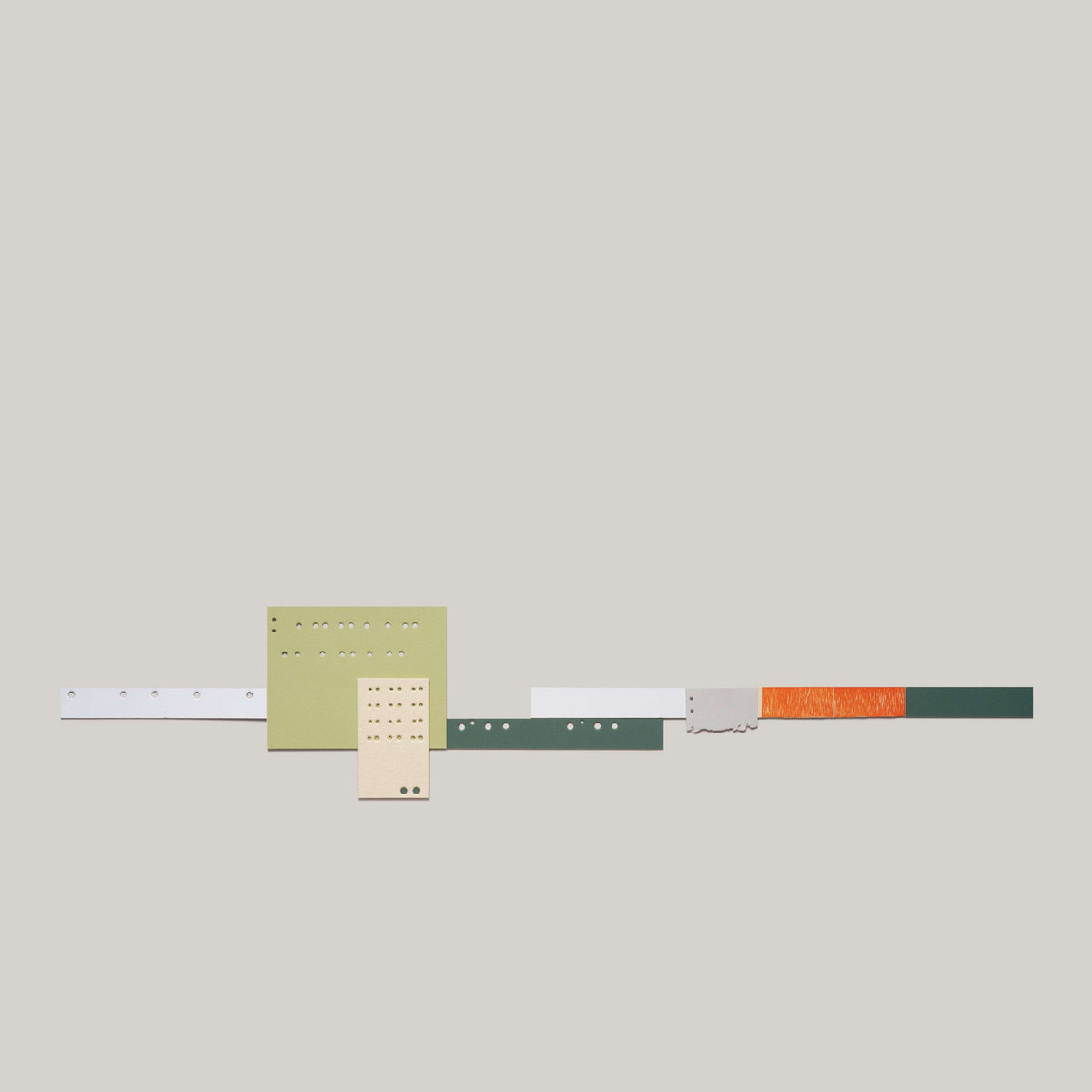 I had a roommate back in the '90s who was deeply into the ambient side of techno, which was something that I intensely loathed at the time. Unbeknownst to me, however, that was my first exposure to the seemingly ubiquitous and eternal Taylor Deupree (via his Human Mesh Dance and Prototype 909 projects). I have since grown to genuinely love his work, of course, but I am sufficiently guilty of taking him for granted that I slept on his landmark 2002 album Stil. The same is not true of Joseph Branciforte (who runs the greyfade label), as he was so taken with the album that he embarked upon a multi-year project to "bring Deupree's explorations of extreme repetition and stillness into the world of notated chamber music." That initially seemed like quite a quixotic endeavor to me, but the resultant album is an absolute revelation, as breaking Deupree's elegantly skipping and sublime ambient magic up into individual acoustic components reveals an incredible degree of harmonic and dynamic sophistication that would have been otherwise lost on me. To paraphrase a scene from Mad Men, hearing Sti.ll after listening to Stil. feels like the moment in The Wizard of Oz when everything unexpectedly bursts into vivid color.
I had a roommate back in the '90s who was deeply into the ambient side of techno, which was something that I intensely loathed at the time. Unbeknownst to me, however, that was my first exposure to the seemingly ubiquitous and eternal Taylor Deupree (via his Human Mesh Dance and Prototype 909 projects). I have since grown to genuinely love his work, of course, but I am sufficiently guilty of taking him for granted that I slept on his landmark 2002 album Stil. The same is not true of Joseph Branciforte (who runs the greyfade label), as he was so taken with the album that he embarked upon a multi-year project to "bring Deupree's explorations of extreme repetition and stillness into the world of notated chamber music." That initially seemed like quite a quixotic endeavor to me, but the resultant album is an absolute revelation, as breaking Deupree's elegantly skipping and sublime ambient magic up into individual acoustic components reveals an incredible degree of harmonic and dynamic sophistication that would have been otherwise lost on me. To paraphrase a scene from Mad Men, hearing Sti.ll after listening to Stil. feels like the moment in The Wizard of Oz when everything unexpectedly bursts into vivid color. The enigmatic, inscrutable, and defunct Austrian duo of Jürgen Weber and Lili Novy/Frl. Tost has long been a subject of fascination for me, as I have had a bunch of their albums for years and enjoyed them, yet knew virtually nothing about them at all. In fact, I still would find it incredibly challenging to even answer a simple question like "what does Nový Svět sound like?" as their elusive discography continually blurs the lines between industrial, folk, cabaret, improv, collage, and whatever other esoteric influences they decided to assimilate for a given album. Amusingly, they also had a quixotic tendency to record albums in languages other than their native German, as evidenced by this newly released album from the vaults, which was originally intended to complete a "Spanish trilogy" back in 2007. In characteristically contrarian and mystifying fashion, it was shelved for being "too Spanish" and a synth album (Todas Las Últimas Cosas) was released instead. If this were any other band, I would drive myself crazy wondering why they would allow such an mesmerizing and wonderfully weird album to languish unheard, but baffling choices were basically the norm for Nový Svět. In any case, this album rules and I am thrilled to finally get to hear it.
The enigmatic, inscrutable, and defunct Austrian duo of Jürgen Weber and Lili Novy/Frl. Tost has long been a subject of fascination for me, as I have had a bunch of their albums for years and enjoyed them, yet knew virtually nothing about them at all. In fact, I still would find it incredibly challenging to even answer a simple question like "what does Nový Svět sound like?" as their elusive discography continually blurs the lines between industrial, folk, cabaret, improv, collage, and whatever other esoteric influences they decided to assimilate for a given album. Amusingly, they also had a quixotic tendency to record albums in languages other than their native German, as evidenced by this newly released album from the vaults, which was originally intended to complete a "Spanish trilogy" back in 2007. In characteristically contrarian and mystifying fashion, it was shelved for being "too Spanish" and a synth album (Todas Las Últimas Cosas) was released instead. If this were any other band, I would drive myself crazy wondering why they would allow such an mesmerizing and wonderfully weird album to languish unheard, but baffling choices were basically the norm for Nový Svět. In any case, this album rules and I am thrilled to finally get to hear it. This unusual drum and guitar duo first surfaced back in the dark days of early 2020 with The Quickening, which they boldly recorded without ever having previously performed together. Obviously, both artists are seasoned improvisers and excellent musicians, but I was still taken aback by the instant and incredible chemistry on pieces like that album's title track. Given the significant hurdles like distance, touring schedules, and other collaborations, it understandably took quite some time before the opportunity to reconvene presented itself, but the duo finally managed to meet up in White's native Australia in 2022 for some recording sessions in the coastal town of Point Lonsdale. The resultant album feels a bit different from its predecessor for a couple of reasons (no acoustic guitars this time around, "big change of vibe and scenery"), but the three-part "Bitterroot Valley Suite" beautifully recaptures the magic and spontaneity of the pair's debut while also breaking some very compelling new ground.
This unusual drum and guitar duo first surfaced back in the dark days of early 2020 with The Quickening, which they boldly recorded without ever having previously performed together. Obviously, both artists are seasoned improvisers and excellent musicians, but I was still taken aback by the instant and incredible chemistry on pieces like that album's title track. Given the significant hurdles like distance, touring schedules, and other collaborations, it understandably took quite some time before the opportunity to reconvene presented itself, but the duo finally managed to meet up in White's native Australia in 2022 for some recording sessions in the coastal town of Point Lonsdale. The resultant album feels a bit different from its predecessor for a couple of reasons (no acoustic guitars this time around, "big change of vibe and scenery"), but the three-part "Bitterroot Valley Suite" beautifully recaptures the magic and spontaneity of the pair's debut while also breaking some very compelling new ground. Despite her slim discography, Montreal-based Myriam Gendron has quietly amassed a very passionate following over the last few years, which is quite an impressive feat given that she frequently sings in French and the bulk of her previous oeuvre was devoted to interpretations of French/Québécois traditional music or Dorothy Parker poems. Obviously, such fare is quite far from the zeitgeist of the present time, but that is a big part of Gendron's allure: her work taps into a deeper and more timeless vein that captures the joy and pain of being alive in an unusually profound and direct way. Those same themes unsurprisingly remain central on Mayday (it was assembled in the wake of her mother's passing), but this third album is Gendron's first to focus primarily on her own original compositions as well as her first release to be professionally recorded in an actual studio. To celebrate that auspicious occasion, Gendron is joined by a host of talented collaborators like Dirty Three's Jim White, Body/Head's Bill Nace, and Marisa Anderson. Characteristically, the result is yet another absolutely mesmerizing Myriam Gendron album.
Despite her slim discography, Montreal-based Myriam Gendron has quietly amassed a very passionate following over the last few years, which is quite an impressive feat given that she frequently sings in French and the bulk of her previous oeuvre was devoted to interpretations of French/Québécois traditional music or Dorothy Parker poems. Obviously, such fare is quite far from the zeitgeist of the present time, but that is a big part of Gendron's allure: her work taps into a deeper and more timeless vein that captures the joy and pain of being alive in an unusually profound and direct way. Those same themes unsurprisingly remain central on Mayday (it was assembled in the wake of her mother's passing), but this third album is Gendron's first to focus primarily on her own original compositions as well as her first release to be professionally recorded in an actual studio. To celebrate that auspicious occasion, Gendron is joined by a host of talented collaborators like Dirty Three's Jim White, Body/Head's Bill Nace, and Marisa Anderson. Characteristically, the result is yet another absolutely mesmerizing Myriam Gendron album. This latest boxed set to emerge from Will Long's Celer reissue campaign celebrates one of the project's more recent works, as It Would Be Giving Up was originally released as a digital-only album back in late 2020. As was the case with previous reissues, the album has been remastered by Stephan Mathieu, but the more exciting bit is that I had never actually heard this particular album before and it instantly became my favorite Celer release by a wide margin. That makes sense, as according to Long, It Would Be Giving Up is thematically tied to two of Celer's other recent classics (Future Predictions and Memory Repetitions), as the three albums focus upon "ensemble pieces made with tape loops and analog instruments" and share a certain "wall of sound" aesthetic. While my love of Future Predictions is well-documented and remains as strong as ever, I now believe that It Would Be Giving Up is the single most essential album in Celer's entire discography, as it beautifully transcends the ambient/drone milieu to strain towards ecstatic heartache as high art.
This latest boxed set to emerge from Will Long's Celer reissue campaign celebrates one of the project's more recent works, as It Would Be Giving Up was originally released as a digital-only album back in late 2020. As was the case with previous reissues, the album has been remastered by Stephan Mathieu, but the more exciting bit is that I had never actually heard this particular album before and it instantly became my favorite Celer release by a wide margin. That makes sense, as according to Long, It Would Be Giving Up is thematically tied to two of Celer's other recent classics (Future Predictions and Memory Repetitions), as the three albums focus upon "ensemble pieces made with tape loops and analog instruments" and share a certain "wall of sound" aesthetic. While my love of Future Predictions is well-documented and remains as strong as ever, I now believe that It Would Be Giving Up is the single most essential album in Celer's entire discography, as it beautifully transcends the ambient/drone milieu to strain towards ecstatic heartache as high art. My familiarity with James Vella is primarily through his role running the excellent Phantom Limb label, but that is just one facet of a varied career, as he is also a fiction writer and a member of the Canterbury-based post-rock ensemble Yndi Halda. He records as a solo artist too and has been sporadically releasing albums as A Lily for almost two decades now. Notably, Vella is also of Maltese descent, which inspired this wonderful stylistic detour: Saru l-Qamar is assembled from tapes of home recordings archived by the Maltese heritage organization Magna Żmien. Naturally, that made my ears perk up immediately, as I often enjoy the crackling and hissing escapism of dispatches from long-dead people in far-flung places, but the “oneiric bliss” of Vella’s achingly beautiful and hallucinatory collages proved to be an unexpected and welcome enhancement. This is one of my favorite albums of the year thus far.
My familiarity with James Vella is primarily through his role running the excellent Phantom Limb label, but that is just one facet of a varied career, as he is also a fiction writer and a member of the Canterbury-based post-rock ensemble Yndi Halda. He records as a solo artist too and has been sporadically releasing albums as A Lily for almost two decades now. Notably, Vella is also of Maltese descent, which inspired this wonderful stylistic detour: Saru l-Qamar is assembled from tapes of home recordings archived by the Maltese heritage organization Magna Żmien. Naturally, that made my ears perk up immediately, as I often enjoy the crackling and hissing escapism of dispatches from long-dead people in far-flung places, but the “oneiric bliss” of Vella’s achingly beautiful and hallucinatory collages proved to be an unexpected and welcome enhancement. This is one of my favorite albums of the year thus far. Will Long's ambitious campaign to remaster and reissue key highlights from Celer's overwhelmingly vast discography continues with this expanded reincarnation of 2009's Engaged Touches (appropriately released on fellow ex-pat/ambient artist Ian Hawgood's Home Normal label during its Japan-based era). The album is an especially noteworthy release within the Celer canon for a couple of reasons, but the big one is that it ranks alongside 2008's Discourses of the Withered and 2019's Xièxie as one of the project's perennial fan favorites. While my own pantheon of essential Celer albums does not always align with that of said fanbase, this one's prominent place makes sense, as it was definitely one of the most high-profile albums released during the white-hot height of Celer-mania. As such, it was probably one of the first Celer albums that many people heard. It is also inarguably one of the strongest albums recorded during the project's early days as a husband-and-wife duo with Danielle Baquet-Long (Chubby Wolf) and most of the other contenders were not yet widely available before Bandcamp transformed the musical landscape. Given that, a reissue was both welcome and inevitable, but those who already love this album will likely be thrilled by the prospect of hearing it in its newly expanded and remastered form.
Will Long's ambitious campaign to remaster and reissue key highlights from Celer's overwhelmingly vast discography continues with this expanded reincarnation of 2009's Engaged Touches (appropriately released on fellow ex-pat/ambient artist Ian Hawgood's Home Normal label during its Japan-based era). The album is an especially noteworthy release within the Celer canon for a couple of reasons, but the big one is that it ranks alongside 2008's Discourses of the Withered and 2019's Xièxie as one of the project's perennial fan favorites. While my own pantheon of essential Celer albums does not always align with that of said fanbase, this one's prominent place makes sense, as it was definitely one of the most high-profile albums released during the white-hot height of Celer-mania. As such, it was probably one of the first Celer albums that many people heard. It is also inarguably one of the strongest albums recorded during the project's early days as a husband-and-wife duo with Danielle Baquet-Long (Chubby Wolf) and most of the other contenders were not yet widely available before Bandcamp transformed the musical landscape. Given that, a reissue was both welcome and inevitable, but those who already love this album will likely be thrilled by the prospect of hearing it in its newly expanded and remastered form.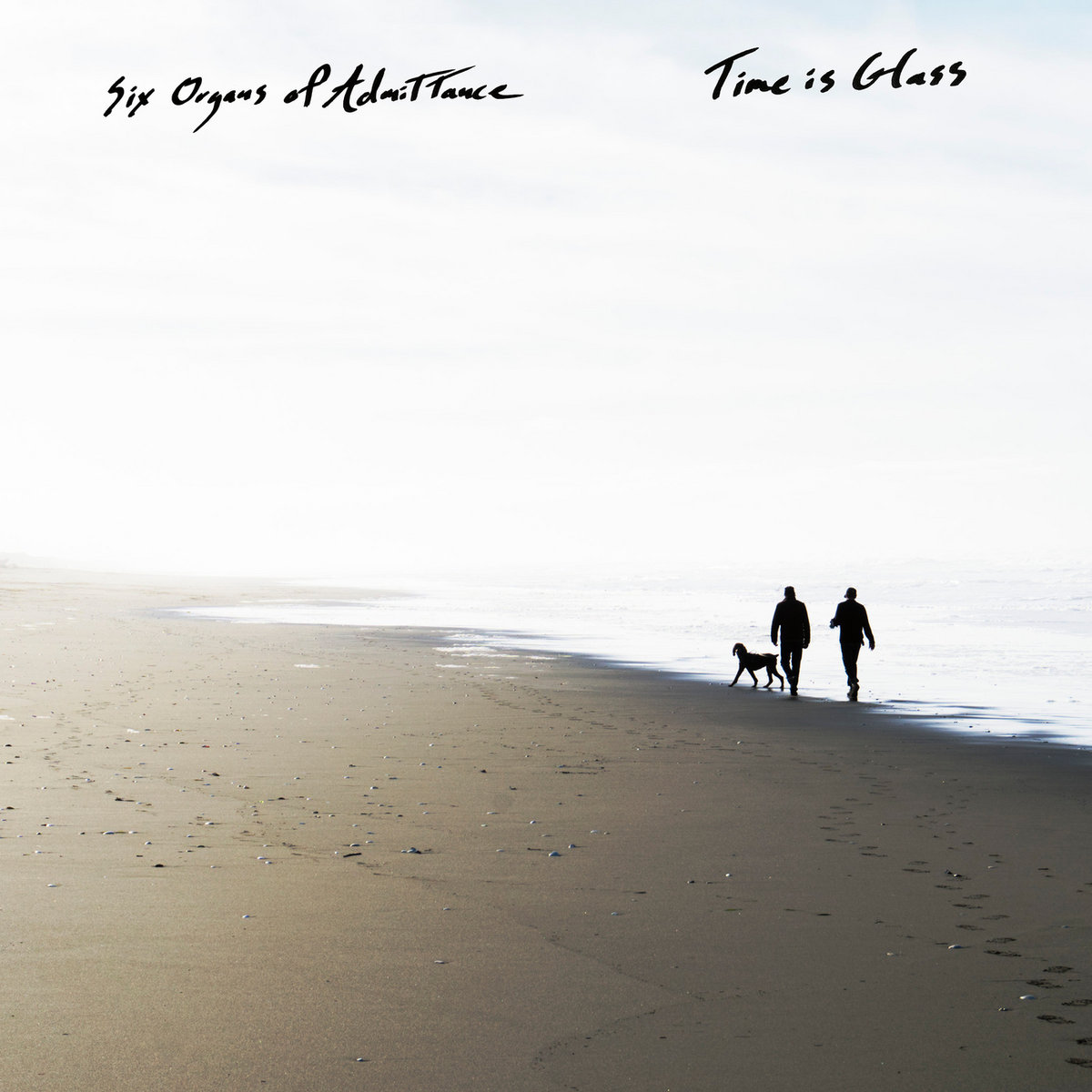 This latest release from Ben Chasney's shapeshifting and long-running psych project is billed as a sort of homecoming album, as Chasney recently moved back to California's famed Humboldt County region after a few decades away. As befits an album recorded on a picturesque coast best known for weed and beautiful redwood forests, Time Is Glass is an especially intimate, casual, and mellow Six Organs album (the cover art of a beachside dog walk captures the tone quite nicely, I think). Admittedly, that softer side of Six Organs is usually not my cup of tea (I am a fundamentally un-mellow person), but I genuinely appreciate Chasney's passion for continual evolution and reinvention and there is already a sizable backlog of Six Organs material that falls more in my comfort zone. As such, I am always willing to indulge Chasney's erratic muse wherever it may lead. More importantly, I consider Chasney to be something of a fitful and unpredictable guitar visionary: there are admittedly plenty of Six Organs songs that leave me cold, but it is never safe to assume that a new Chasney album will be devoid of flashes of brilliance. In keeping with that theme, Time Is Glass is a bit of an uneven album for me, but it does feature two sustained flashes of brilliance that rank among Chasney's finest work.
This latest release from Ben Chasney's shapeshifting and long-running psych project is billed as a sort of homecoming album, as Chasney recently moved back to California's famed Humboldt County region after a few decades away. As befits an album recorded on a picturesque coast best known for weed and beautiful redwood forests, Time Is Glass is an especially intimate, casual, and mellow Six Organs album (the cover art of a beachside dog walk captures the tone quite nicely, I think). Admittedly, that softer side of Six Organs is usually not my cup of tea (I am a fundamentally un-mellow person), but I genuinely appreciate Chasney's passion for continual evolution and reinvention and there is already a sizable backlog of Six Organs material that falls more in my comfort zone. As such, I am always willing to indulge Chasney's erratic muse wherever it may lead. More importantly, I consider Chasney to be something of a fitful and unpredictable guitar visionary: there are admittedly plenty of Six Organs songs that leave me cold, but it is never safe to assume that a new Chasney album will be devoid of flashes of brilliance. In keeping with that theme, Time Is Glass is a bit of an uneven album for me, but it does feature two sustained flashes of brilliance that rank among Chasney's finest work.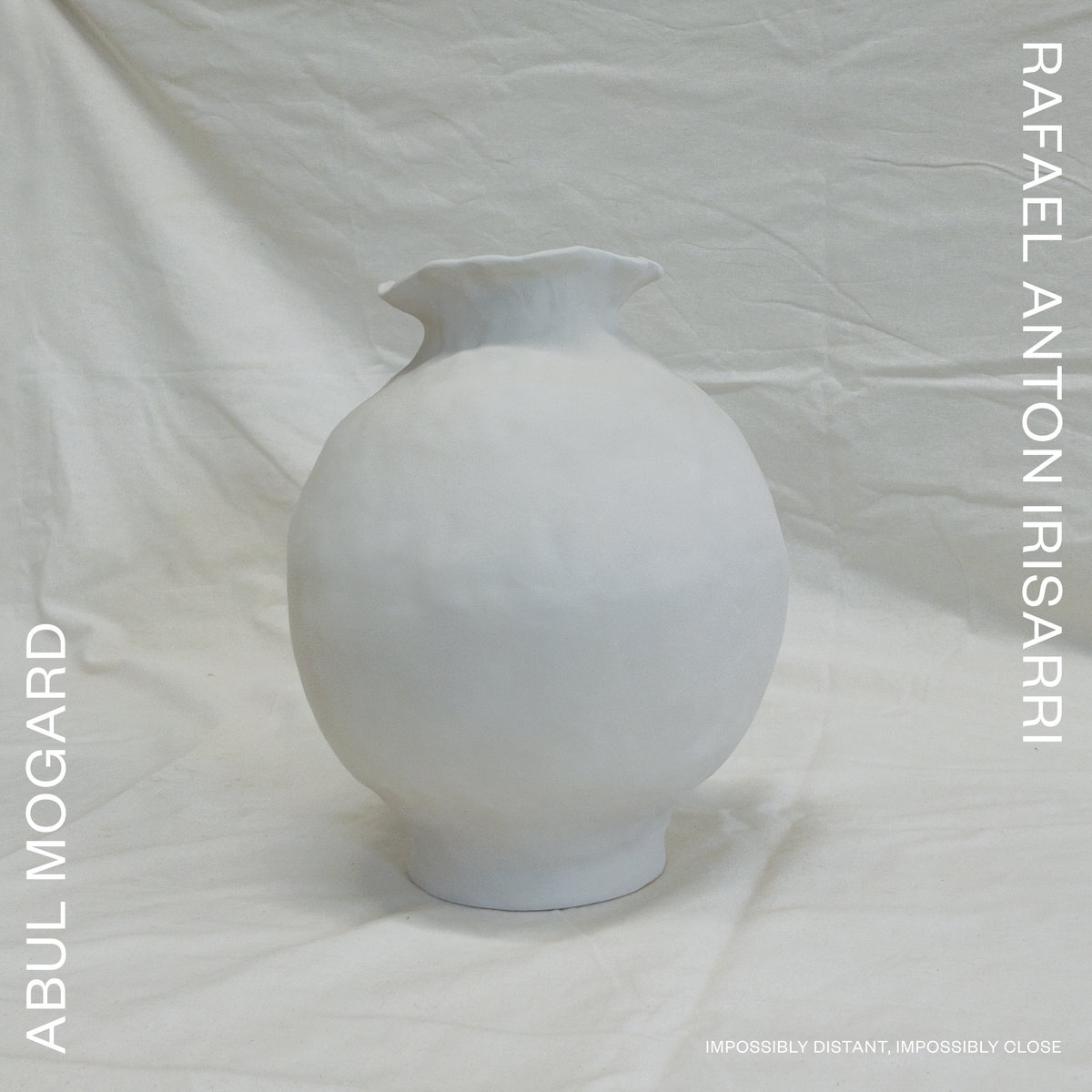 This collaboration has its origins in a sold-out opening night show from Madrid's 2023 SoundSet series, as Irisarri and Guido Zen tore the roof off the Condeduque cultural center ambient-style with their encore duet. Naturally, that intense performance ("Waking Up Dizzy on a Bastion") is included here for the benefit of hapless chumps like me who were on the wrong continent that night, but the experience inspired the two artists to keep their partnership going afterwards (albeit remotely). That continued creative union eventually resulted in a longform studio piece ("Place of Forever") that is every bit as impressive as the Madrid performance, if not even better. Unsurprisingly, I have been a fan of both artists for quite some time and this album is one of those rare times in which an ostensible match made in heaven actually sounds as absolutely mesmerizing as I hoped it would. This album is pure blackened drone nirvana.
This collaboration has its origins in a sold-out opening night show from Madrid's 2023 SoundSet series, as Irisarri and Guido Zen tore the roof off the Condeduque cultural center ambient-style with their encore duet. Naturally, that intense performance ("Waking Up Dizzy on a Bastion") is included here for the benefit of hapless chumps like me who were on the wrong continent that night, but the experience inspired the two artists to keep their partnership going afterwards (albeit remotely). That continued creative union eventually resulted in a longform studio piece ("Place of Forever") that is every bit as impressive as the Madrid performance, if not even better. Unsurprisingly, I have been a fan of both artists for quite some time and this album is one of those rare times in which an ostensible match made in heaven actually sounds as absolutely mesmerizing as I hoped it would. This album is pure blackened drone nirvana. After teasingly releasing a pair of soundtracks under his given name, Adam Wiltzie's latest solo album marks a return (of sorts) to the ambient/drone terrain of his beloved former duo with the late Brian McBride (Stars of the Lid). Unsurprisingly, the titular barbiturate/anesthetic deserves some credit for inspiring this shift in direction, as Wiltzie sometimes yearns for a "sacred escape" from the "daily emotional meat grinder of life," but the album also drew inspiration from his recent move to the Flemish countryside and a recurring dream ("if someone listened to the music I created, then they would die"). Based on my own listening experience, I can tentatively say that the album is probably not lethal (outside of dreams, at least) and also that it will presumably delight those Wiltzie fans who have been patiently longing for such a "return to form." That said, Wiltzie's vision is characteristically a bit of an understated one, so the pleasures of Eleven Fugues for Sodium Pentothal tend to be subtle, ephemeral, and sneakily slow-burning ones.
After teasingly releasing a pair of soundtracks under his given name, Adam Wiltzie's latest solo album marks a return (of sorts) to the ambient/drone terrain of his beloved former duo with the late Brian McBride (Stars of the Lid). Unsurprisingly, the titular barbiturate/anesthetic deserves some credit for inspiring this shift in direction, as Wiltzie sometimes yearns for a "sacred escape" from the "daily emotional meat grinder of life," but the album also drew inspiration from his recent move to the Flemish countryside and a recurring dream ("if someone listened to the music I created, then they would die"). Based on my own listening experience, I can tentatively say that the album is probably not lethal (outside of dreams, at least) and also that it will presumably delight those Wiltzie fans who have been patiently longing for such a "return to form." That said, Wiltzie's vision is characteristically a bit of an understated one, so the pleasures of Eleven Fugues for Sodium Pentothal tend to be subtle, ephemeral, and sneakily slow-burning ones. This latest full-length from Australian composer Madeleine Cocolas is billed as a companion piece to 2022’s acclaimed Spectral, as the two albums have something of a conceptual yin/yang relationship: Spectral was devoted to “evoking memories and emotions,” while Bodies “is about being present in your body.” The title also has a dual meaning this time around, as Cocolas sought to explore “similarities between bodies of water and human bodies” and “blur the boundaries between them.” As is the case with most conceptual inspirations behind instrumental albums, it is hard to say how much of that actually comes through in the music, but it makes for interesting contextual background and it seems to have triggered a significant creative evolution, as Madeleine makes beautiful use of manipulated field recordings. That element alone is enough to set her apart from other ambient/drone artists in the Room40 milieu, but I was also struck by her talents for sound design and virtuosic ability to interweave countless moving parts in dynamically compelling ways. At its best, Bodies feels like a minor deep listening/headphone masterpiece.
This latest full-length from Australian composer Madeleine Cocolas is billed as a companion piece to 2022’s acclaimed Spectral, as the two albums have something of a conceptual yin/yang relationship: Spectral was devoted to “evoking memories and emotions,” while Bodies “is about being present in your body.” The title also has a dual meaning this time around, as Cocolas sought to explore “similarities between bodies of water and human bodies” and “blur the boundaries between them.” As is the case with most conceptual inspirations behind instrumental albums, it is hard to say how much of that actually comes through in the music, but it makes for interesting contextual background and it seems to have triggered a significant creative evolution, as Madeleine makes beautiful use of manipulated field recordings. That element alone is enough to set her apart from other ambient/drone artists in the Room40 milieu, but I was also struck by her talents for sound design and virtuosic ability to interweave countless moving parts in dynamically compelling ways. At its best, Bodies feels like a minor deep listening/headphone masterpiece. This is the vinyl debut from American Primitive-inspired French guitarist Raoul Eden, but it previously surfaced as a self-released CD back in 2023 (a previous “incarnation,” if you will). That makes the chronology of Eden’s evolution a little blurry, as his other album (Anima, released on Scissor Tail) was recorded that same year. In any case, Incarnation is an absolute tour de force, as Eden tries his damndest to fill the void left by Jack Rose’s passing and gamely spices up his “primitive psychedelic blues” vision by incorporating Indian, Arabic, Turkish, Moroccan, and Taureg influences. Obviously, the solo steel string guitarist tradition of looking to the East for cool ideas goes back to at least Robbie Basho, but Eden executes that assimilation quite beautifully (and unusually seamlessly). In fact, Eden executes just about everything beautifully and that is the bit that elevates Incarnation into something quite striking and singular, as he brings an ecstatic intensity to almost every single one of these six pieces, resulting in a strain of fingerstyle guitar that often gloriously feels like a runaway train leaving a rain of sparks in its wake.
This is the vinyl debut from American Primitive-inspired French guitarist Raoul Eden, but it previously surfaced as a self-released CD back in 2023 (a previous “incarnation,” if you will). That makes the chronology of Eden’s evolution a little blurry, as his other album (Anima, released on Scissor Tail) was recorded that same year. In any case, Incarnation is an absolute tour de force, as Eden tries his damndest to fill the void left by Jack Rose’s passing and gamely spices up his “primitive psychedelic blues” vision by incorporating Indian, Arabic, Turkish, Moroccan, and Taureg influences. Obviously, the solo steel string guitarist tradition of looking to the East for cool ideas goes back to at least Robbie Basho, but Eden executes that assimilation quite beautifully (and unusually seamlessly). In fact, Eden executes just about everything beautifully and that is the bit that elevates Incarnation into something quite striking and singular, as he brings an ecstatic intensity to almost every single one of these six pieces, resulting in a strain of fingerstyle guitar that often gloriously feels like a runaway train leaving a rain of sparks in its wake.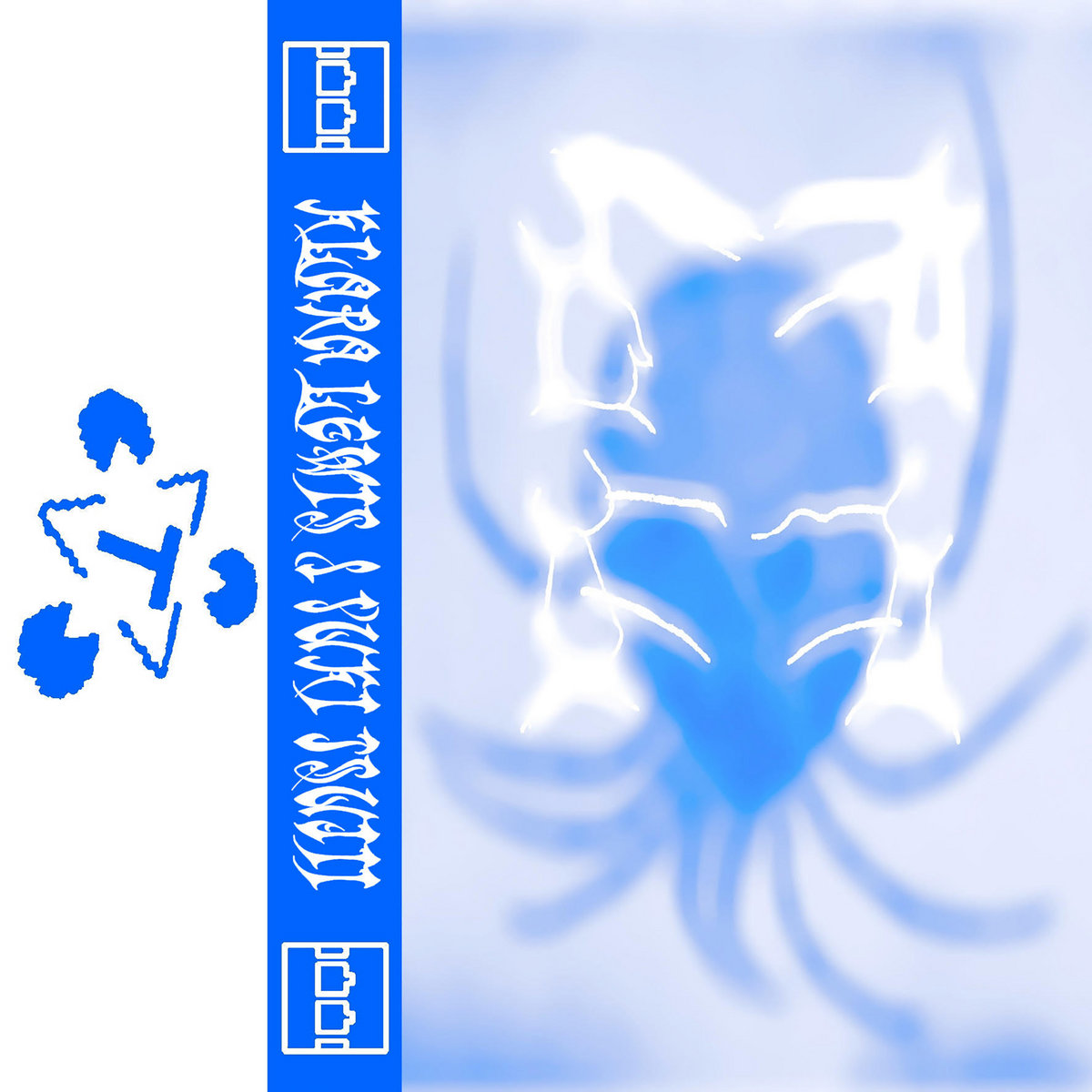 I am always eager to hear anything new from the reliably weird and inventive Klara Lewis, but the unpredictability of her collaborative releases is especially pronounced. Notably, Salt Water is the first of those collaborations in which I was not previously familiar with her creative foil. It also seems like quite a leftfield pairing on paper, given that Yuki Tsujii is best known as the guitarist for a hard-to-categorize Japanese rock band based in London (Bo Ningen). Fortunately, everything made sense once I learned that Tsujii is now based in Stockholm (Lewis is Swedish) and that he had previously collaborated with both Faust and Keiji Haino (his primal, convulsive playing here would be right at home on an album by the latter). Also of note: Lewis is described as a "loop finder" in the album's description, which feels like an extremely apt description of her role on Salt Water. Unsurprisingly, the loops that she found are extremely cool, resulting in an album that often sounds like scrabbling guitar noise assaulting an eclectic array of '60s exotica, classical, and film score samples.
I am always eager to hear anything new from the reliably weird and inventive Klara Lewis, but the unpredictability of her collaborative releases is especially pronounced. Notably, Salt Water is the first of those collaborations in which I was not previously familiar with her creative foil. It also seems like quite a leftfield pairing on paper, given that Yuki Tsujii is best known as the guitarist for a hard-to-categorize Japanese rock band based in London (Bo Ningen). Fortunately, everything made sense once I learned that Tsujii is now based in Stockholm (Lewis is Swedish) and that he had previously collaborated with both Faust and Keiji Haino (his primal, convulsive playing here would be right at home on an album by the latter). Also of note: Lewis is described as a "loop finder" in the album's description, which feels like an extremely apt description of her role on Salt Water. Unsurprisingly, the loops that she found are extremely cool, resulting in an album that often sounds like scrabbling guitar noise assaulting an eclectic array of '60s exotica, classical, and film score samples. This Swiss percussionist has been quietly carving out a very cool and unique niche for himself over the last decade, as he continually finds unusual conceptual scenarios to combine with his virtuosic playing. I greatly enjoyed 2021's aptly titled Locked Grooves, but had not yet delved too deeply into his earlier work, so I had missed the first installment of Hidden Tracks: 2017's Basel – Genève. For that album, Sartorius brought his drumsticks along for a 10-day, 270km hike along Switzerland's Jura Ridgeway Trail and recorded improvised beats on whatever intriguing sound sources he encountered (trees, empty silos, corn stalks, etc.). On this latest installment, his journey is now vertical, as Sartorius kept a similar beat diary as he climbed from the Italian village of Domodossola "to the peak of Weissmies (4017m above sea level) in the Swiss Valais." In theory, that upped the game considerably constraint-wise, as Sartorius gradually leaves behind both humanity and trees in his ascent, but that comparative dearth of available sound sources was no match for his resourceful inventiveness.
This Swiss percussionist has been quietly carving out a very cool and unique niche for himself over the last decade, as he continually finds unusual conceptual scenarios to combine with his virtuosic playing. I greatly enjoyed 2021's aptly titled Locked Grooves, but had not yet delved too deeply into his earlier work, so I had missed the first installment of Hidden Tracks: 2017's Basel – Genève. For that album, Sartorius brought his drumsticks along for a 10-day, 270km hike along Switzerland's Jura Ridgeway Trail and recorded improvised beats on whatever intriguing sound sources he encountered (trees, empty silos, corn stalks, etc.). On this latest installment, his journey is now vertical, as Sartorius kept a similar beat diary as he climbed from the Italian village of Domodossola "to the peak of Weissmies (4017m above sea level) in the Swiss Valais." In theory, that upped the game considerably constraint-wise, as Sartorius gradually leaves behind both humanity and trees in his ascent, but that comparative dearth of available sound sources was no match for his resourceful inventiveness. I believe I stumbled upon Moonshake's singular 1992 debut full-length by blind luck at a used record store, but I cannot remember if I picked it up because I was already vaguely aware that Margaret Fiedler was cool or if it was still pre-Laika. In any case, I always thought of Moonshake primarily as Fieldler's alternately frustrating and brilliant first band. In hindsight, however, I failed to appreciate how truly radical this foursome were during their brief flourish and dearly wish that I had dug a bit deeper back then, as Eva Luna could have (and should have) been my gateway into an amazing world of killer underground music that I was not yet aware of (krautrock, post-punk, free jazz, Jamaican dub, and even the C86 scene). Listening to this expanded reissue now with considerably more adventurous ears, I still find this album oft-frustrating, but I am newly struck by how almost every song features at least one moment where Moonshake sounded like the best band on the goddamn planet. That white-hot inspiration did not always sustain itself for an entire song, but this reissue beautifully strengthens the original album with some welcome gems from the band's early EPs.
I believe I stumbled upon Moonshake's singular 1992 debut full-length by blind luck at a used record store, but I cannot remember if I picked it up because I was already vaguely aware that Margaret Fiedler was cool or if it was still pre-Laika. In any case, I always thought of Moonshake primarily as Fieldler's alternately frustrating and brilliant first band. In hindsight, however, I failed to appreciate how truly radical this foursome were during their brief flourish and dearly wish that I had dug a bit deeper back then, as Eva Luna could have (and should have) been my gateway into an amazing world of killer underground music that I was not yet aware of (krautrock, post-punk, free jazz, Jamaican dub, and even the C86 scene). Listening to this expanded reissue now with considerably more adventurous ears, I still find this album oft-frustrating, but I am newly struck by how almost every song features at least one moment where Moonshake sounded like the best band on the goddamn planet. That white-hot inspiration did not always sustain itself for an entire song, but this reissue beautifully strengthens the original album with some welcome gems from the band's early EPs. This album is definitely one of the more unlikely underground hits to cross my path in recent memory, as this strikingly unique bagpipe performance first quietly surfaced as an extremely limited CDr back in 2017 on Strasbourg's Soleils Bleus label. Last year, however, it got a well-deserved vinyl resurrection on Belgium's forward-thinking Morc Records and it sold out almost immediately (as did last month's repress, unsurprisingly). Notably, the bagpipe has historically not been my favorite instrument, but I've said the same thing in the past about harps and harpsichords only to have my mind blown by Joanna Newsom, Mary Lattimore, and Catherine Christer Hennix, so this is merely the latest revelation that any instrument can sound amazing in the right hands. I also never expected the French traditional music scene to be the source of so many stellar contemporary albums, yet Lise and Lisa have just joined my personal pantheon of Gallic folkies (France, Tanz Mein Herz, etc.) who have dropped killer left-field psych gems in recent years. That is an especially impressive feat for Kaüffert, given that she is a German bagpiper.
This album is definitely one of the more unlikely underground hits to cross my path in recent memory, as this strikingly unique bagpipe performance first quietly surfaced as an extremely limited CDr back in 2017 on Strasbourg's Soleils Bleus label. Last year, however, it got a well-deserved vinyl resurrection on Belgium's forward-thinking Morc Records and it sold out almost immediately (as did last month's repress, unsurprisingly). Notably, the bagpipe has historically not been my favorite instrument, but I've said the same thing in the past about harps and harpsichords only to have my mind blown by Joanna Newsom, Mary Lattimore, and Catherine Christer Hennix, so this is merely the latest revelation that any instrument can sound amazing in the right hands. I also never expected the French traditional music scene to be the source of so many stellar contemporary albums, yet Lise and Lisa have just joined my personal pantheon of Gallic folkies (France, Tanz Mein Herz, etc.) who have dropped killer left-field psych gems in recent years. That is an especially impressive feat for Kaüffert, given that she is a German bagpiper.
